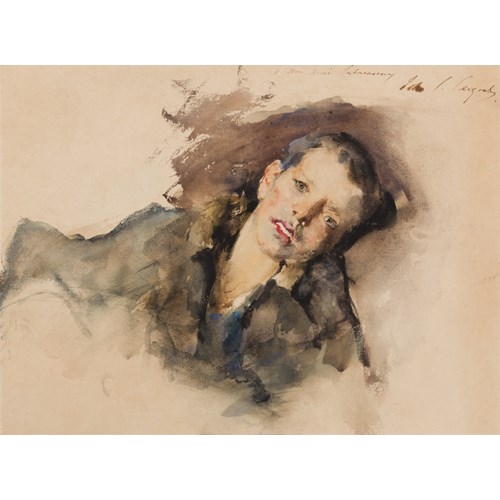Hubert Robert
An Architectural Capriccio of Roman Ruins with Figures
Medium Watercolour, pen and black ink, on two joined sheets of paper
Dimension 32.5 x 65 cm (12³/₄ x 25⁵/₈ inches)
A signed but undated watercolour by Hubert Robert of an identical composition and of similar dimensions is in the State Hermitage Museum in St. Petersburg. Also in the same collection is a pendant watercolour of An Architectural Capriccio with the Colosseum and the Statue of Marcus Aurelius, which is signed and dated 1758. (Both Hermitage watercolours are, however, in very poor condition.) Some of the main architectural and sculptural elements in the present drawing are also found in a watercolour of an Architectural Capriccio with Roman Monuments and Washerwomen, formerly attributed to Robert, in the Metropolitan Museum of Art in New York.
It has been suggested that the present sheet may have been the large capriccio watercolour by Hubert Robert once owned by the 18th century artist Charles-Joseph Natoire (1700-1777) and sold in his posthumous sale in 1778, as ‘Un grand Dessin colorié & compose de différens monumens de anciens Romains: on y distingue le Panthéon, le Tombeau de Bacchus, les Chevaux de Monte Cavallo, la Colonne Trajane, l’Arc de Constantin, & la Pyramide ce Cestius.’. The first known modern owner of this watercolour was the 20th century French industrialist Maurice de Wendel (1879-1961).
Medium: Watercolour, pen and black ink, on two joined sheets of paper
Signature: Inscribed and dated an T(?) Octobre 1761, with a paraphe, on the verso, backed.
Dimension: 32.5 x 65 cm (12³/₄ x 25⁵/₈ inches)
Provenance: Possibly Charles-Joseph Natoire, Paris
Possibly the posthumous vente Natoire, Paris, Hôtel d’Aligre [Paillet], 14 December 1778 onwards, lot 103 (‘Un grand Dessin colorié & compose de différens monumens de anciens Romains: on y distingue le Panthéon, le Tombeau de Bacchus, les Chevaux de Monte Cavallo, la Colonne Trajane, l’Arc de Constantin, & la Pyramide ce Cestius.’, bt. Benoit for 404 livres)
Maurice de Wendel, Paris and the Château de la Brouchetière, Joeuf
Anonymous sale, Paris, Hôtel George V [Ader Picard Tajan], 18 March 1981, lot 103.
Private collection.
Literature: Catherine Boulot et al, J. H. Fragonard e H. Robert a Roma, exhibition catalogue, Rome, 1990-1991, p.57, under no.5, fig.5b.
Exhibition: Paris, Galerie Cailleux, Le dessin français de Watteau à Prud’hon, April 1951, no.117 (as Vue dans les ruines de Rome, lent by Maurice de Wendel).
Plus d'œuvres d'art de la Galerie









